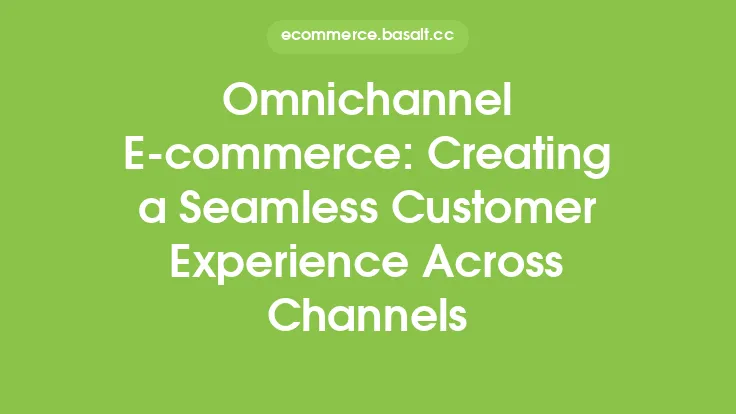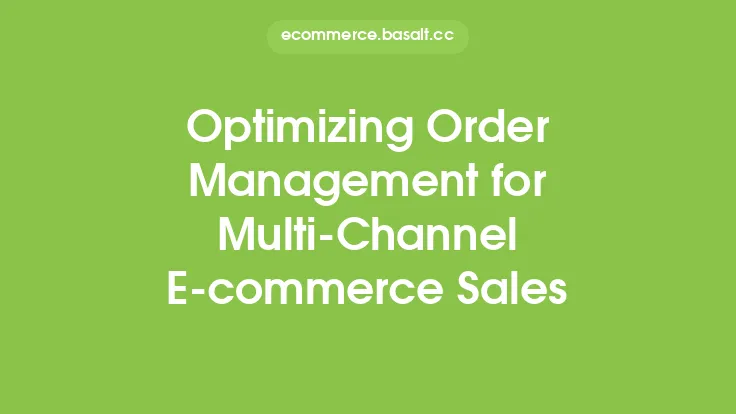In today's digital age, e-commerce has become an essential part of any business's sales strategy. With the rise of online shopping, customers expect a seamless and consistent experience across all channels, including social media, online marketplaces, and physical stores. Creating a multi-channel e-commerce experience is crucial for businesses to stay competitive and meet the evolving needs of their customers. A well-designed multi-channel strategy allows businesses to reach their customers wherever they are, provide a consistent brand experience, and ultimately drive sales and revenue.
Understanding the Importance of Multi-Channel E-commerce
Multi-channel e-commerce refers to the practice of selling products or services through multiple channels, such as a website, social media, online marketplaces, and physical stores. This approach allows businesses to reach a wider audience, increase brand visibility, and provide a more convenient shopping experience for customers. A multi-channel strategy also enables businesses to collect valuable customer data and insights, which can be used to improve marketing efforts, optimize product offerings, and enhance the overall customer experience.
Key Components of a Seamless Multi-Channel E-commerce Experience
To create a seamless multi-channel e-commerce experience, businesses must consider several key components, including:
- Consistent branding: Ensuring that the brand's message, visual identity, and tone are consistent across all channels.
- Unified product information: Providing accurate and up-to-date product information, including pricing, availability, and product descriptions, across all channels.
- Streamlined ordering and fulfillment: Allowing customers to place orders and receive fulfillment notifications across multiple channels, with options for in-store pickup, shipping, or curbside delivery.
- Omnichannel customer service: Providing customer support through multiple channels, including phone, email, chat, and social media, to ensure that customers receive timely and effective assistance.
- Integrated inventory management: Managing inventory levels across all channels, including physical stores, warehouses, and online marketplaces, to ensure that products are available when customers want to buy them.
Strategies for Creating a Seamless Multi-Channel E-commerce Experience
To create a seamless multi-channel e-commerce experience, businesses can employ several strategies, including:
- Implementing a single customer view: Creating a single customer profile that aggregates data from all channels, providing a comprehensive understanding of customer behavior and preferences.
- Using cloud-based e-commerce platforms: Leveraging cloud-based e-commerce platforms that provide scalability, flexibility, and integration with multiple channels, including social media, online marketplaces, and physical stores.
- Investing in order management systems: Implementing order management systems that can handle orders from multiple channels, providing real-time inventory updates, and automating fulfillment processes.
- Developing mobile apps and progressive web apps: Creating mobile apps and progressive web apps that provide a seamless shopping experience, with features such as push notifications, personalized recommendations, and streamlined checkout processes.
Best Practices for Managing a Multi-Channel E-commerce Strategy
To manage a multi-channel e-commerce strategy effectively, businesses should follow several best practices, including:
- Monitoring and analyzing customer behavior: Tracking customer behavior across all channels, analyzing data to identify trends and patterns, and using insights to inform marketing and product development strategies.
- Providing ongoing training and support: Ensuring that customer-facing staff are trained to provide excellent customer service, and that they have the necessary tools and resources to support customers across all channels.
- Continuously evaluating and improving the customer experience: Gathering feedback from customers, identifying areas for improvement, and implementing changes to enhance the overall customer experience.
- Staying up-to-date with the latest e-commerce trends and technologies: Attending industry events, participating in online forums, and reading industry publications to stay informed about the latest e-commerce trends and technologies.
Overcoming Common Challenges in Multi-Channel E-commerce
While creating a seamless multi-channel e-commerce experience can be challenging, there are several common obstacles that businesses can overcome with the right strategies and technologies. These challenges include:
- Integrating disparate systems and channels: Using integration platforms, APIs, and other technologies to connect disparate systems and channels, providing a unified view of customer data and inventory levels.
- Managing inventory and fulfillment across multiple channels: Implementing inventory management systems that can handle multiple channels, providing real-time inventory updates, and automating fulfillment processes.
- Providing consistent customer service across all channels: Developing customer service strategies that provide consistent support across all channels, including phone, email, chat, and social media.
- Measuring and optimizing the effectiveness of multi-channel strategies: Using analytics and performance metrics to measure the effectiveness of multi-channel strategies, identifying areas for improvement, and making data-driven decisions to optimize the customer experience.
Conclusion
Creating a seamless multi-channel e-commerce experience is essential for businesses to stay competitive in today's digital age. By understanding the importance of multi-channel e-commerce, implementing key components, and employing effective strategies, businesses can provide a consistent and convenient shopping experience for customers across all channels. By following best practices, overcoming common challenges, and staying up-to-date with the latest e-commerce trends and technologies, businesses can drive sales, revenue, and customer loyalty, ultimately achieving long-term success in the e-commerce market.





